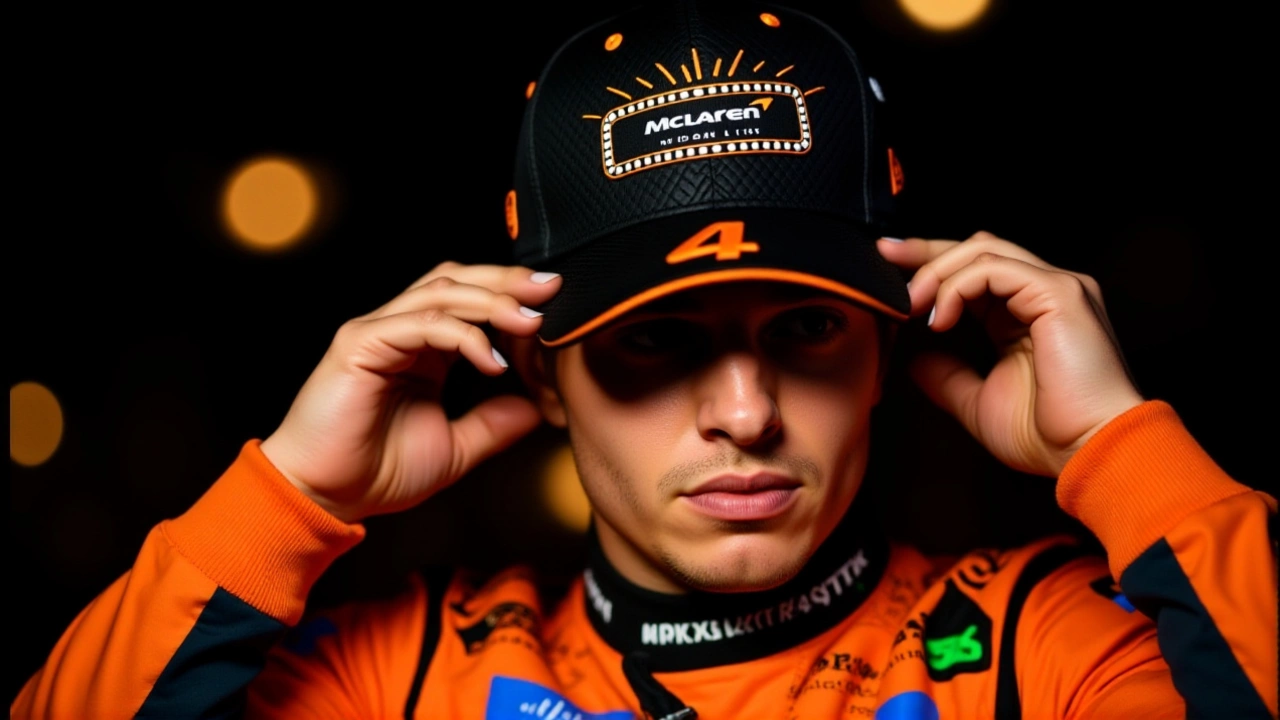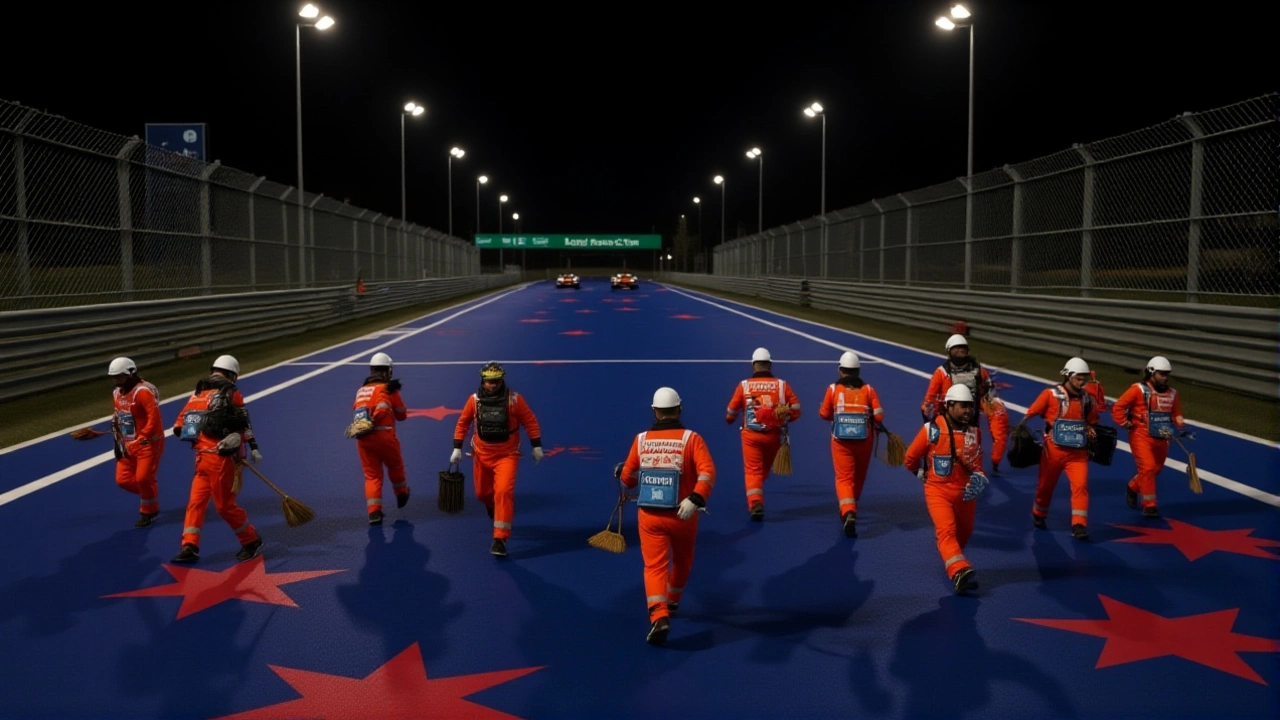The Fédération Internationale de l'Automobile has declared it had no concerns about marshals working in the Turn 1 run-off area during the Las Vegas Grand Prix — even as cars roared past them at over 200 mph on the second lap. The incident, which unfolded at approximately 10:05 PM PST on November 23, 2024, sparked immediate concern among fans and drivers alike. But according to FIA officials, the situation was handled correctly — and crucially, the marshals were never on the racing surface.
What Happened at Turn 1?
At the start of the race, a multi-car pileup erupted at Turn 1 involving Lando Norris and Oscar Piastri, both driving for McLaren. Debris scattered across the runoff zone, prompting U.S. Race Management (USRM) to deploy intervention marshals immediately. These volunteers, many of them local residents from Southern Nevada, moved quickly into the gravel trap and runoff area — but not onto the tarmac itself.By the time the field approached Turn 1 on the second lap, the marshals were still clearing debris from the edge of the track. Max Verstappen, driving the Oracle Red Bull Racing car #1, passed through the zone at full speed. The Race Director Niels Wittich confirmed in a post-race briefing that Race Control had anticipated this exact scenario. "They were never on the racing line," he said. "We knew they’d be there. We timed it. They were clear of the track before the cars arrived."
Why This Wasn’t Like Mexico
The comparison to the Mexican Grand Prix on October 27, 2024 was inevitable. There, Liam Lawson nearly collided with two marshals who had mistakenly entered the racing surface. A communication breakdown meant the VSC wasn’t activated in time. In Las Vegas, that didn’t happen."There was no miscommunication," said Herbie Blash, FIA Deputy Race Director. "Every radio call was logged. Every marshal position was confirmed. Sector 1 Chief Marshal Robert 'Bobby' Thompson — a 17-year veteran — was in constant contact with Race Control."
The FIA’s stance hinges on Article 35.8 of the 2024 Sporting Regulations, which allows marshals to operate in runoff areas without neutralizing the race — as long as they’re not on the track. The difference between "runoff" and "racing surface" is technical but critical. Runoff areas are designed to absorb impacts, not to be driven on. Marshals working there are protected by barriers, gravel, and clear visual separation from the track. In Mexico, marshals crossed that line. In Las Vegas, they didn’t.

How the Safety System Responded
When debris was later found on the actual racing surface at 10:13:17 PM PST, Race Control didn’t hesitate. The Virtual Safety Car was deployed immediately. Double-waved yellow flags were already active through Turn 1, and a single yellow was added before the start/finish line to warn drivers on the short straight. The entire response took under 8 minutes — from debris discovery to VSC activation."That’s textbook," said David Stohl, CEO of U.S. Race Management. "We train for this. We rehearse it. We know the timing. We know the flags. We know the radio protocol."
The Locals’ Marshal Program: A New Model for Safety
Behind the scenes, the real story is the Locals’ Marshal Program. Organized by USRM in partnership with Las Vegas Grand Prix LLC, the program trained 600 volunteers — 247 of them from Southern Nevada — over three weekends in September 2024 at the Las Vegas Motor Speedway.Each marshal completed 12 hours of training: flag signals, vehicle recovery, radio comms, and emergency response. Many were former military, firefighters, or motorsport fans with no prior F1 experience. Their presence wasn’t just logistical — it was symbolic. This was a race on the Strip, but safety was rooted in the community.
"We didn’t bring in outsiders," said Thompson. "We trained our neighbors. People who live five miles from the track. They knew what this race meant to the city. They weren’t just volunteers — they were stakeholders."

What Comes Next?
Applications for the 2025 marshal program opened on May 15, 2025, and close on June 2, 2025, at 11:59 PM PST. USRM expects another 600 spots to fill within days. The FIA has signaled it may expand this model to other new circuits — especially in the U.S. — where local engagement improves safety culture."This isn’t just about marshals being in the right place," said Blash. "It’s about trust. When the people who work the flags know the track, know the drivers, know the risks — they make better decisions. That’s the real win here."
Frequently Asked Questions
Why didn’t the FIA deploy the Safety Car during the initial cleanup?
The FIA determined that marshals were operating only in the runoff area — not on the racing surface — which under Article 35.8 of the 2024 Sporting Regulations does not require race neutralization. Double-waved yellow flags were already in place, and Race Control confirmed via radio that marshals were positioned safely away from the track line. The VSC was only activated later when debris was found on the actual racing surface.
How is this different from the Mexican Grand Prix incident?
In Mexico, marshals entered the racing surface due to a miscommunication between Race Control and the local team, forcing Liam Lawson to brake suddenly. In Las Vegas, no such error occurred. Radio logs show continuous, confirmed communication between Sector 1 Chief Marshal Robert Thompson and Race Control, ensuring marshals remained strictly in the runoff zone. The FIA confirmed no breach of protocol occurred.
Who are the marshals working at the Las Vegas Grand Prix?
The 600 marshals for the 2024 event were part of the Locals’ Marshal Program, with 247 being Southern Nevada residents trained through a certification program held at the Las Vegas Motor Speedway in September 2024. They underwent 12 hours of FIA-approved training in flagging, vehicle recovery, and emergency response — many with no prior motorsport experience, but deep local ties to the event.
What role does U.S. Race Management play in F1 safety?
U.S. Race Management (USRM), headquartered in Olathe, Kansas, is responsible for all trackside safety operations at the Las Vegas Grand Prix under FIA oversight. They recruit, train, and deploy marshals, manage flagging systems, coordinate with Race Control, and ensure compliance with international safety standards. Their leadership under CEO David Stohl has been praised for integrating local communities into elite motorsport safety protocols.
When will the 2025 Las Vegas Grand Prix marshals be selected?
Applications for the 2025 Locals’ Marshal Program opened on May 15, 2025, and closed on June 2, 2025, at 11:59 PM PST. U.S. Race Management will select 600 volunteers based on training performance, availability, and community engagement. Selected marshals will undergo refresher training in September 2025 ahead of the November race.
Is this model being adopted elsewhere in Formula 1?
Yes. The FIA has expressed interest in replicating the Las Vegas model at other new or urban circuits, particularly in the U.S. and Asia, where local engagement improves safety culture and operational efficiency. Officials are already evaluating similar programs for the Miami and Saudi Arabian Grands Prix, though none have yet matched the scale or community integration of Las Vegas.

 Sports
Sports